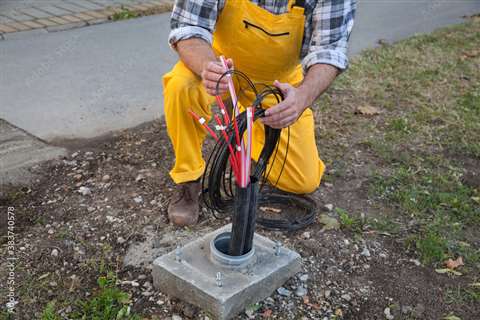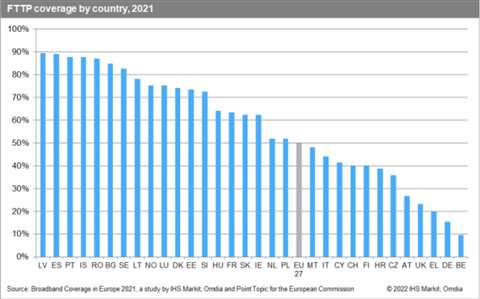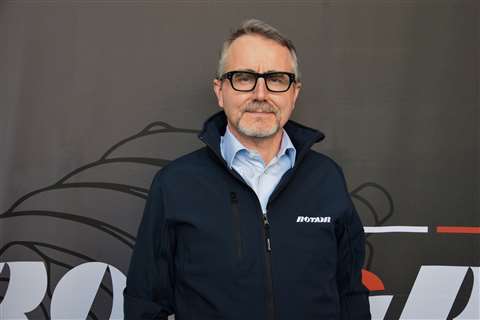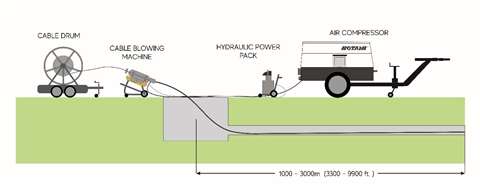Fibre optic cabling: the challenges and opportunities
17 February 2023
Alex Persyn, director of product management, Rotair Portable Compressors, discusses the role of compressed air in meeting demands for next generation access, fibre optic cable based high-speed data.
 A worker installs fibre optic cables. (Photo: AdobeStock)
A worker installs fibre optic cables. (Photo: AdobeStock)
Today, businesses and consumers are demanding reliable high speed data connections, through air waves (such as WiFi, Bluetooth or GSM signals) or by cable.
This demand has only grown following the pandemic and the increased use of ‘smart working’ from home.
To keep up with the demand, the European Commission has set a number of clear goals for connectivity speeds.
By 2025, the commission aims to make available at least 100Mbps for all European households and 1000Mbps or 1Gbps for all main socio-economic drivers (such as schools, research facilities, hospitals).
The accelerated roll-out of fibre optic cables throughout Europe is a large part of the answer to the targets set by the Commission.
To achieve this efficiently, compressed air has an important role in meeting the connectivity challenges of the future.
Definitions for types of broadband
| DSL | DSL (for Digital Subscriber Line) is the basic technology used to provide broadband over conventional telephone lines (copper cables) |
| VDSL | VDSL is a “Very-high-speed” version of DSL |
| FTTP | FTTP (fibre-to-the-premises) is broadband provided over fibreoptic cables going all the way to the home or business premises. This definition also includes “FTTB”, where fibre terminates at a large building and broadband distribution within the building, to different flats for example, is by a different non-fibre technology such as VDSL |
| NGA | Next generation access |
The growth of fibre connection in Europe
According to a 2021 EU Commission study on Broadband coverage in Europe, from June 2020 to June 2021 there was a 7% increase in the number of homes passed by FTTP networks – reaching 50.0% of EU homes in total.
Despite this, 13 countries recorded FTTP coverage below the EU average. However, the demand for fibre continues and is only set to accelerate as more countries recognise that upgrading existing (copper) cables imposes limits on the future speed and performance of connections. Across the EU in the latest study period (June 2020 to June 2021):
-
Six countries reached FTTP coverage levels higher than 80%: Spain, Portugal, Iceland, Romania, Bulgaria, and Sweden
-
Nine countries recorded double-digit growth in FTTP coverage: Cyprus, France, Hungary, Ireland, Italy, Lithuania, the Netherlands, Romania, and Slovakia.
-
FTTP coverage expanded more quickly than other fixed broadband technologies in rural areas. Rural FTTP availability increased by 8.0 percentage points, reaching a third (33.8%) of rural EU households.
 FTTP coverage in Europe by country 2021
FTTP coverage in Europe by country 2021
Fibre optic connectivity in the UK
-
The UK ranked among the countries with the lowest overall FTTP & DOCSIS 3.1 coverage levels.
-
The UK incumbent BT/Openreach has revisited its network deployment strategy in recent years and is now focussed primarily on FTTP rollouts over legacy network upgrades.
-
The result of this has been continued strong growth in FTTP coverage and by mid-2021, 23.3% of households had access to FTTP broadband services, 8.8% higher than in 2020, but still below the EU average of 50%.
Challenges and opportunities of fibre optic cable laying
Countries are increasingly turning to fibre optic cables, despite the additional infrastructure required in installation, because one of the biggest advantages of fibre optics is that they can handle much more data than older copper cables.
Fibre optic cables have a higher bandwidth, which means they can carry more information. However, this means new cables versus upgrading existing copper cables – and this commonly requires digging a trench and laying the tube in the trench, to which the fibre optic cable is then inserted.
Fibre optic cables consist of glass threads, each capable of transmitting digital data modulated into light waves.
They effectively send information coded in a beam of light through a glass or plastic pipe. Given the importance of preserving the integrity of the cables, utmost precision in process is required.
How to prepare for fibre optic installation
Cleaning of the tube is important to ensure success in the whole process, minimising friction when blowing the fibre optic cable later on.
To do this, a sponge is blown through the tube with max. 14 bars of air pressure to remove the initial dirt. Then another sponge is blown through the tube, this time with a lubricant to reduce friction.
Europe’s fibre network market growth
 Alex Persyn, director of product management, Rotair Portable Compressors.
Alex Persyn, director of product management, Rotair Portable Compressors.
Alex Persyn answers some of the key questions behind the push for FTTP connectivity in Europe, and reveals the role of contractors in the installation process.
What’s driving the growth of fibre optic in Europe?
From a technological perspective, it’s clear that a lot of regions are trying to catch up, and if you look at Europe it’s working hard to become digital proof, with the UK and Germany among the biggest hotspot regions for growth.
What challenges do contractors face with fibre optic cable installation?
For contractors, the main challenge will be the installation of the cable, which requires particular care and knowhow.
On the cost side, we are talking about building new networks with special equipment. In best case fibre cables can be blown in available ducts, in other cases trenching is required which means more time and more labour.
How can contractors overcome the challenges of installing fibre optic cables?
There’s a lot of focus on efficiency as there is no room for trial and error as the fibre cables are expensive and all projects are running against tight timelines.
The best results are achieved by experienced teams supported by reliable equipment. For example, we are seeing the sector increasingly use smart blowing machines.
These, combined with compressors like ours can help contractors overcome some of those challenges they face.
What opportunities does the demand for fibre connection bring for contractors?
The European Commission has set clear connectivity targets to make Europe digital proof. Firstly, to have at least 100Mbps for all European households and 1000Mbps or 1Gbps for all main socio-economic drivers by 2025.
Secondly, the Commission has also set a target of 2030 for all European households to be covered by gigabit networks. Every target is quite ambitious and requires sufficient teams in the field to make it happen.
Especially in regions where operators have historically focused on upgrading legacy copper and cable networks, fibre projects are now booming business.
Are there any barriers to integration for particular regions?
The good thing about our VRK Fibra models, which are tailored to the fibre segment, is that they are powered by a petrol engine. This means they’re not affected by stage or tier emission legislations which affect other diesel-powered equipment.
The other models in our range which accommodate different phases in fibre roll-out projects might have a different spec depending on the region where you go to, but it does not change the approach to flow, pressure or the aftercooling of the compressed air.
At this stage when the fibre optic cable is mechanically fed into the tube by the blow-in machine, it is critical to maintain a constant and reliable air flow as up to several hundred metres of fibre optic cable is fed into the blow-in machine from the reel car, itself which should be positioned correctly to ensure unobstructed cable feeding.
The environmental impact of fibre
The growing attention to climate change has led to more awareness of the environmental impact of technology.
In that context, digitisation is one of the leverages for a lower CO2 emission as it leads to the creation of new applications which make it possible to work more efficiently and to save energy.
The use of fibre raises the level of digitization, so that multiple sectors can become greener. Fibre also contributes more directly to a greener society.
While the electrical pulses in copper or cable networks need to be boosted, the light signal in the fibre can be sent over longer distances. As such fibre networks work at higher speeds, meaning that by using the same amount of energy more information can be sent.
 A summary of how an air compressor is used when installing fibre optic cables. (Photo: Rotair)
A summary of how an air compressor is used when installing fibre optic cables. (Photo: Rotair)
Air compressor for fibre optic cable blowing
Cable blowing is the process of inserting an optical fibre cable into a duct by combining a mechanical pushing force (pneumatic, electric or hydraulic) and a high-speed air flow.
After the traction rollers in the blowing device pushed the cable for a few hundred meters, compressed air is injected in the duct.
By introducing compressed air, the cable inside the duct remains in floating condition, which reduces friction between the cable outer surface and duct inner wall.
The compressor role is therefore critical in the efficient and reliable installation of fibre optic cables. It is elementary that the compressor is correctly sized for the project, is able to deliver 14 bar air pressure, is able to cool the compressed air close to ambient temperature and has a moisture separator.
The role of technology in next generation connectivity
As the demand for fibre grows across Europe and around the world, the reliable and efficient installation of fibre optic cables and the work of its installers will come under increasing pressure.
However, by making the necessary preparations, utilising the right equipment and seeking specialised support, companies can avoid costly mistakes and develop the expertise and capability necessary to bring efficient and reliable next generation access to the world.




